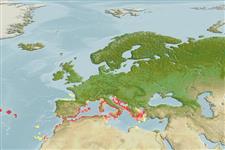Классификация / Names
народные названия | синонимы | Catalog of Fishes(род, виды) | ITIS | CoL | WoRMS | Cloffa
>
Blenniiformes (Blennies) >
Tripterygiidae (Triplefin blennies) > Tripterygiinae
Etymology: Tripterygion: Greek, tres tria = three + Greek, pteron = wing, fin; diminutive (Ref. 45335); tartessicum: Named for the old Spanish culture (Tartessos, at least dating from 1000 BC), located on the south coast of the Iberian peninsula (in modern Andalusia, Spain), where the new species is partially distributed..
Environment: milieu / climate zone / depth range / distribution range
экология
морской демерсальный; пределы глубины 0 - 6 m (Ref. 58124), usually 0 - 3 m (Ref. 58124). Tropical
Mediterranean and Eastern Central Atlantic: along the southern coast of Spain, from Plage David (Morocco) to Tunisia.
Size / Вес / Возраст
Maturity: Lm ? range ? - ? cm
Max length : 7.7 cm TL самец/пол неопределен; (Ref. 58124)
Краткое описание
определительные ключи | морфология | морфометрия
колючие лучи спинного плавника (общее число) : 19 - 21; членистые (мягкие) лучи спинного плавника (общее число) : 12 - 13; колючие лучи анального плавника: 2; членистые (мягкие) лучи анального плавника: 22 - 24. This species has an elongated and compressed body, greatest height at base of anal fin, being about one-sixth total length. Entire body with ctenoid scales except base of pectoral fin and ventral abdominal region back to vent. Lateral line with an anterior section with 20 (19-22) pored scales, and a posterior section with 22 (21-24) notched scales, total of 42 (40-46). Upper, anterior, section commencing at upper angle of opercular opening, slightly curving up over the pectoral fin base and running parallel to the dorsal profile to a point below last 1-3 rays of second dorsal fin; canal running across exposed width of each scale. Lower,
posterior, section commencing below, and in front of last scale or two of upper section, running along the mid-line of tail to caudal fin base; each scale with shallow notch in free-edge tip (Ref. 58124).
Adults inhabit similar habitats to Tripterygion tripteronotus, shallow rocky shores to 6 m,
preferably between 0 and 3 m; in light-exposed and shady biotopes dominated by algal communities (e.g. Corallina elongata, Cladophora spp., Litophyllum spp., Enteromorpha spp.). Nests are usually situated in sciaphyl habitats dominated by
steep rocky zones, without arborescent algae (Ref. 58124). Eggs are hemispherical and covered with numerous sticky threads that anchor them in the algae on the nesting sites (Ref. 240). Larvae are planktonic which occur primarily in shallow, nearshore waters (Ref. 94114).
Life cycle and mating behavior
Maturities | размножение | Spawnings | Egg(s) | Fecundities | личинки
Carreras-Carbonell, J., M. Pascual and E. Macpherson, 2007. A review of the Tripterygion tripteronotus (Risso, 1810) complex, with a description of a new species from the Mediterranean Sea (Teleostei: Tripterygiidae). Scientia Marina 71(1):75-86. (Ref. 58124)
Статус Красного Списка МСОП (Ref. 130435)
Угроза для людей
Harmless
Использование человеком
дополнительная информация
инструменты
Специальные отчеты
Скачать в формате XML
ресурсы в Интернет
Estimates based on models
Preferred temperature (Ref.
123201): 17.6 - 20.1, mean 18.9 °C (based on 213 cells).
Phylogenetic diversity index (Ref.
82804): PD
50 = 0.5625 [Uniqueness, from 0.5 = low to 2.0 = high].
Bayesian length-weight: a=0.00692 (0.00371 - 0.01290), b=3.10 (2.93 - 3.27), in cm total length, based on LWR estimates for this species & (Sub)family-body (Ref.
93245).
Trophic level (Ref.
69278): 3.4 ±0.4 se; based on size and trophs of closest relatives
устойчивость к внешним воздействиям (Ref.
120179): высокий, минимальное время удвоения популяции до 15 месяцев (Preliminary K or Fecundity.).
Fishing Vulnerability (Ref.
59153): Low vulnerability (10 of 100).
